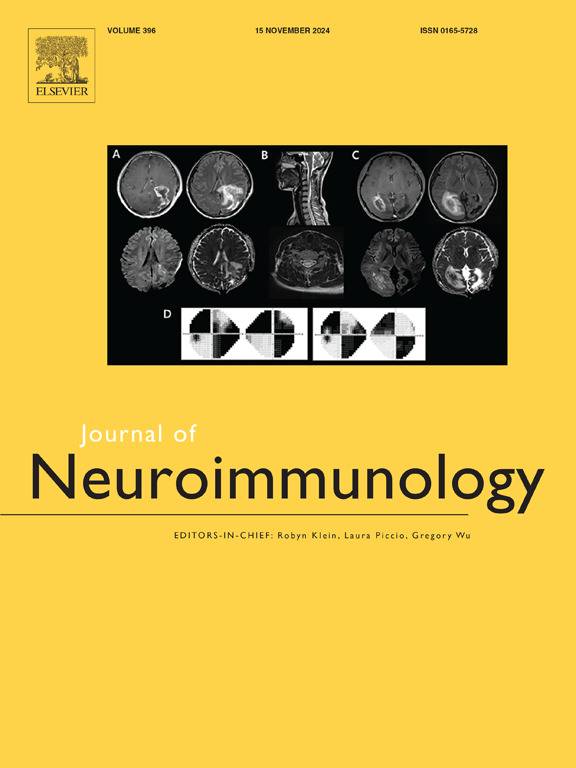toll样受体2和4影响小鼠腹根挤压损伤后的神经元存活和神经胶质反应
IF 2.5
4区 医学
Q3 IMMUNOLOGY
引用次数: 0
摘要
周围神经损伤后,免疫分子的表达增加,如主要组织相容性复合体I类(MHC-I)和toll样受体(tlr2和4),主要与突触稳定性或消除有关。本研究旨在评估TLR2和4在腹侧根压碎(VRC)后神经元存活、胶质反应和突触覆盖中的可能作用。为此,选用8周龄雄性C57BL6/JUnib、TLR2敲除株和TLR4敲除株。接受L4, L5和L6腹根粉碎手术的动物,C57BL/6JUnib小鼠进一步细分为对照组和先前用TLR2和TLR4激动剂(分别为Pam3CSK4和LPS)刺激的动物组;术前1小时)。损伤后7和14天,收集脊髓进行运动神经元存活分析、免疫组化(抗iba1、抗gfap、抗synaptophysin)和突触覆盖定量。一组小鼠也以3 dpi的速度进行RT-qPCR和Western blotting处理。结果显示,TLR4基因敲除小鼠在VRC后更容易发生运动神经元丢失,突触覆盖减少,并伴有NF-κB表达增加。相比之下,与野生型小鼠和tlr4缺陷小鼠相比,TLR2敲除小鼠表现出改变的小胶质细胞反应,Il10表达减少,胶质细胞激活谱明显。此外,Pam3CSK4刺激TLR2导致运动神经元周围的小胶质细胞反应更强烈,同时Il10基因表达增加,提示抗炎表型。在TLR4缺失的情况下,在7 dpi时,观察到变形虫小胶质细胞的减少,加上运动神经元的易感性增加和突触覆盖的减少,加强了免疫调节在损伤后早期阶段的重要性。总之,这些发现强调了TLR2和TLR4在VRC后形成神经免疫反应中的独特但互补的作用,这对理解先天免疫信号如何影响运动神经元的存活和修复机制具有重要意义。本文章由计算机程序翻译,如有差异,请以英文原文为准。
Toll-like receptors 2 and 4 influence neuronal survival and glial reactions following ventral root crush injury in mice
Peripheral nerve injuries are followed by an increase in the expression of immune molecules, such as the major histocompatibility complex class I (MHC-I) and Toll-like receptors (TLR 2 and 4), which are mainly related to synaptic stability or elimination. The present study aimed to evaluate the putative role of TLR2 and 4 in neuronal survival, glial reaction and synaptic coverage after ventral root crush (VRC). To this end, 8-week-old male C57BL6/JUnib, TLR2 knockout, and TLR4 knockout strains were used. The animals underwent surgery for the crushing of L4, L5, and L6 ventral roots, and C57BL/6JUnib mice were further subdivided into control groups and groups of animals previously stimulated with TLR2 and TLR4 agonists (Pam3CSK4 and LPS, respectively; 1 h before surgery). Seven- and fourteen-days post-injury, spinal cords were collected for motoneuron survival analysis, immunohistochemistry (anti-Iba1, anti-GFAP, anti-synaptophysin), and synaptic coverage quantification. A subset of mice was also processed at 3 dpi for RT-qPCR and Western blotting. The results showed that TLR4 knockout mice exhibited greater susceptibility to motoneuron loss and decreased synaptic coverage after VRC, accompanied by increased NF-κB expression. In contrast, TLR2 knockout mice showed altered microglial responses, with reduced expression of Il10 and a distinct glial activation profile compared to wild-type mice and TLR4-deficient animals. Additionally, TLR2 stimulation with Pam3CSK4 led to a more intense microglial reaction surrounding motoneurons, along with increased Il10 gene expression, suggesting an anti-inflammatory phenotype. In the absence of TLR4, at 7 dpi, a reduction in amoeboid microglia was observed, which, coupled with the increased susceptibility of motoneurons and decreased synaptic coverage, reinforces the importance of immunomodulation in the early stages after injury. Together, these findings highlight distinct but complementary roles of TLR2 and TLR4 in shaping the neuroimmune response following VRC, with implications for understanding how innate immune signaling influences motoneuron survival and repair mechanisms.
求助全文
通过发布文献求助,成功后即可免费获取论文全文。
去求助
来源期刊

Journal of neuroimmunology
医学-免疫学
CiteScore
6.10
自引率
3.00%
发文量
154
审稿时长
37 days
期刊介绍:
The Journal of Neuroimmunology affords a forum for the publication of works applying immunologic methodology to the furtherance of the neurological sciences. Studies on all branches of the neurosciences, particularly fundamental and applied neurobiology, neurology, neuropathology, neurochemistry, neurovirology, neuroendocrinology, neuromuscular research, neuropharmacology and psychology, which involve either immunologic methodology (e.g. immunocytochemistry) or fundamental immunology (e.g. antibody and lymphocyte assays), are considered for publication.
 求助内容:
求助内容: 应助结果提醒方式:
应助结果提醒方式:


